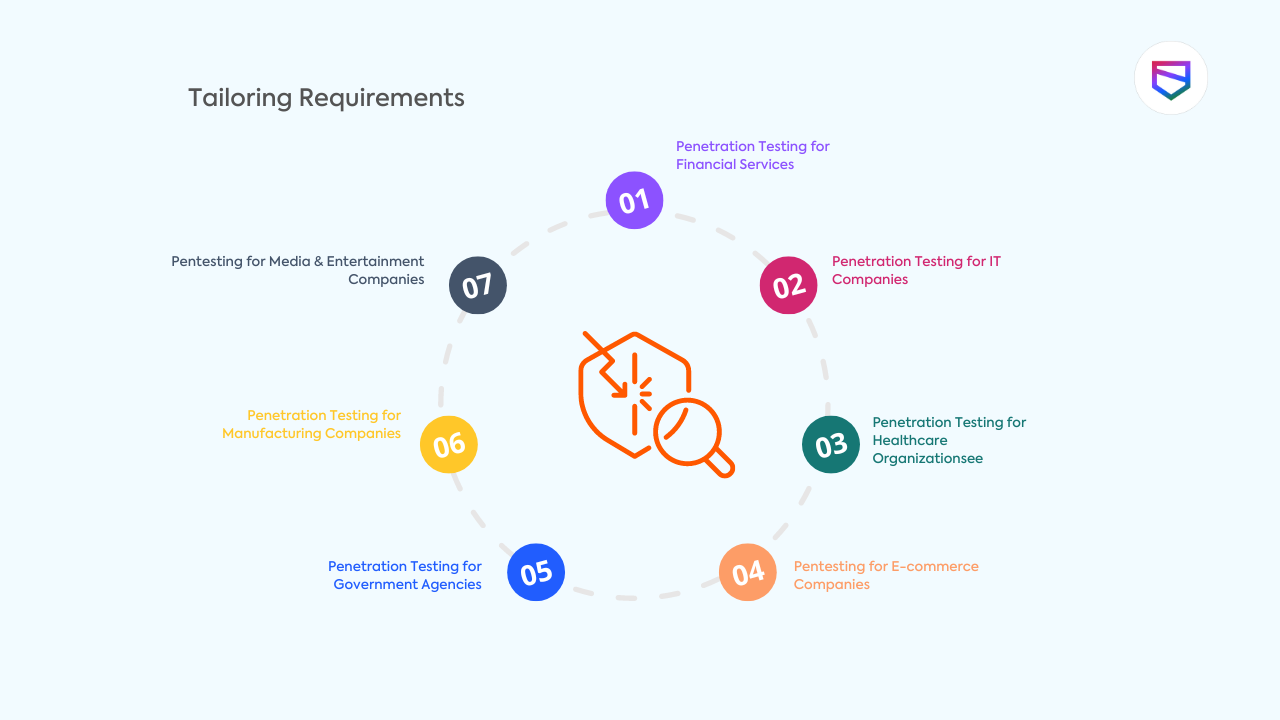
- Home
- Services
- Solutions
- Compliance
- RBI Cyber Security Framework For Banks
- SEBI Cyber Security & Cyber Resilience Framework
- UIDAI – AUA KUA Compliance Security
- RBI Guidelines for Payment Aggregators & Payment Gateways
- RBI Cyber Security Framework For Urban Cooperative Banks
- RBI Guidelines for cyber security in the NBFC Sector
- SAR Audit
- ISO27001
- PCI DSS
- GDPR
- Hipaa Audit
- SOC2 Assessment
- Resources
- Company
- Contact
Penetration Testing Across Industries: Requirements and Assessment Scope
Every industry, from healthcare to finance to manufacturing, is a target for cyberattacks. The question isn’t if you’ll be attacked, but when. And while firewalls and other security measures offer a crucial line of defense, they’re not foolproof. Hidden vulnerabilities hide beneath the surface, waiting to be exploited. That’s where penetration testing comes in. It is a controlled cyberattack conducted by ethical hackers with your permission. They probe your systems, applications, and networks, uncovering vulnerabilities before attackers can exploit them. While the term “pentesting” might sound intimidating, the benefits are undeniable: proactive security, reduced risk, and enhanced compliance. But pen testing isn’t a one-size-fits-all solution. Each industry has its own specific requirements, data sensitivities, and technological complexities. Let’s dig into tailored pen testing approaches for various industries.
Tailoring Requirements: Addressing Industry-Specific Needs
While the core principles of pentesting remain consistent, the specific requirements and nuances vary significantly across industries. Let’s explore the unique considerations for some key sectors:

Let’s Explore
- Penetration Testing for Financial Services
- Penetration Testing for IT Companies
- Penetration Testing for Healthcare Organizations
- Pentesting for E-commerce Companies
- Penetration Testing for Government Agencies
- Penetration Testing for Manufacturing Companies
- Pentesting for Media & Entertainment Companies
1. Penetration Testing for Financial Services:
Financial institutions stand at the forefront of organizations needing robust cybersecurity measures. Protecting sensitive financial data, complying with stringent regulations, and mitigating ever-evolving cyber threats demand a proactive approach, making regular penetration testing crucial. Here’s a detailed look at specific pentesting requirements for financial companies:
High-compliance environment:
Depending on the financial institution’s specific activities and jurisdictions, various other regulations might necessitate compliance with additional security standards and testing requirements.
- PCI DSS: The Payment Card Industry Data Security Standard (PCI DSS) mandates annual internal and external penetration testing for any organization storing, processing, or transmitting cardholder data. This testing must cover all cardholder data environments (CDEs).
- Reserve Bank of India (RBI) Guidelines: RBI requires “robust security controls” for various financial institutions, including banks, payment service providers, and fintech companies. These controls often encompass periodic security assessments and pentesting depending on the specific entity and its risk profile.
- Information Technology Act (2000): This act encourages “reasonable security practices” to protect data, potentially necessitating pentesting depending on the sensitivity of data handled and risk assessments conducted.
- Personal Data Protection Bill (2019): While still awaiting finalization, this proposed bill mandates “appropriate technical and organizational measures” to protect personal data, potentially including pentesting based on data processing activities and risks.
- GLBA Safeguards Rule: The Gramm-Leach-Bliley Act (GLBA) Safeguards Rule mandates risk-based security measures, with penetration testing often serving as a key assessment method.
- NYDFS Cybersecurity Regulation: The New York Department of Financial Services (NYDFS) Cybersecurity Regulation imposes specific technical and organizational controls, including penetration testing of internet-facing systems and applications.
Testing Scope and Methodology:
- Internal and External Testing: Both internal (simulating insider threats) and external (simulating external attacker scenarios) testing are crucial for uncovering a complete picture of vulnerabilities.
- Web Application Testing: Comprehensive testing of online banking platforms, mobile apps, and any other web-based applications handling financial data is critical.
- Network Vulnerability Assessments: Assessing network infrastructure for vulnerabilities that could grant attackers access to sensitive systems is essential.
- Social Engineering Simulations: Evaluating employee awareness and susceptibility to phishing attacks helps identify potential human vulnerabilities.
- Additional Considerations: Depending on the specific needs of the financial institution, testing might also include:
- API Security Assessments: Securing communication channels between applications handling financial data.
- Cloud Security Assessments: Evaluating the security of cloud environments used for financial operations.
- Database Security Assessments: Identifying vulnerabilities in databases storing financial information.
- Physical Security Assessments: Ensuring physical controls protect critical infrastructure and data centers.
2. Penetration Testing for IT Companies:
In the IT industry, data is the lifeblood, and security breaches can be catastrophic, proactive defense strategies are paramount. Penetration testing (pentesting) emerges as a cornerstone of effective security practices, helping IT companies identify and address vulnerabilities before attackers exploit them.
Regulatory Requirements for IT Companies:
- General Data Protection Regulation (GDPR): For IT companies operating in the European Union, GDPR mandates appropriate technical and organizational measures to protect personal data, which can include pentesting depending on the specific context.
- California Consumer Privacy Act (CCPA): Similar to GDPR, CCPA requires businesses operating in California to implement security measures to protect consumer data, potentially including pentesting depending on the specific context.
- Payment Card Industry Data Security Standard (PCI DSS): For any IT company storing, processing, or transmitting cardholder data, annual internal and external pentesting is mandatory under PCI DSS.
- ISO SOC 2 Requirements: While not explicitly mandated by many regulations, ISO SOC 2 has become a widely recognized and respected standard for security and compliance in the IT industry. SOC 2 reports provide independent verification of a company’s adherence to specific Trust Services Criteria (TSC).
- Health Insurance Portability and Accountability Act (HIPAA): For IT companies handling healthcare data, HIPAA’s Security Rule mandates the implementation of “appropriate administrative, technical, and physical safeguards” to protect patient data, which can include pentesting.
- Telecom Regulatory Authority of India (TRAI) Regulations: For IT companies offering telecom-related services (e.g., cloud solutions), TRAI regulations mandate security audits and vulnerability assessments, which might encompass pentesting.
- Reserve Bank of India (RBI) Guidelines: If handling financial data (e.g., payment processing), RBI guidelines mandate specific security controls, potentially involving pentesting depending on the type and volume of data processed.
Beyond Compliance Requirements:
While adhering to regulations is essential, a truly effective pentesting program extends far beyond ticking compliance boxes. Here’s how:
- Web Application Pentesting: The heart of many IT companies lies in their web applications, handling sensitive data, user accounts, and critical functionalities. Rigorous testing that encompasses automated and manual techniques is crucial to uncover vulnerabilities.
- API Security Assessments: IT companies often rely on APIs for communication with external systems, partners, and third-party services. Assessing the security of these APIs is critical to prevent unauthorized access and data breaches.
- Mobile App Pentesting: With the growing popularity of mobile apps in the IT space, testing for vulnerabilities that could compromise user data or facilitate fraudulent activities becomes increasingly important.
- Network Infrastructure Testing: Examining network infrastructure, servers, and databases for weaknesses that could provide attackers with entry points is crucial. This includes assessing cloud environments if applicable.
- Social Engineering Simulations: Evaluating employee awareness and susceptibility to phishing attacks and other social engineering tactics helps mitigate human error, a significant risk factor.
- Cloud Security Assessments: With the increasing adoption of cloud platforms, evaluating the security posture of these environments becomes critical.
- Third-Party Vendor Assessments: Assessing the security posture of third-party vendors integrated with the IT company’s systems can help identify potential vulnerabilities in the supply chain.
3. Penetration Testing for Healthcare Organizations
In healthcare, sensitive patient data intertwines with critical medical technology, robust cybersecurity measures are not just an option, but an ethical and legal imperative. Protecting Electronic Health Records (EHRs), safeguarding medical devices, and ensuring HIPAA compliance demand proactive strategies, with penetration testing (pentesting) emerging as a cornerstone of defense
Regulations in Healthcare Industry:
Healthcare organizations operate within a complex legal landscape, primarily governed by the Health Insurance Portability and Accountability Act (HIPAA). HIPAA’s Security Rule mandates the implementation of “appropriate administrative, technical, and physical safeguards” to protect patient data. While not explicitly requiring pentesting, the rule’s emphasis on risk-based assessments makes it a key tool for identifying and mitigating vulnerabilities. Additionally, specific state and industry regulations, such as the HITRUST CSF, might impose further testing requirements.
National Health Authority (NHA) Guidelines: NHA, responsible for implementing India’s digital health ecosystem, recommends regular security assessments and penetration testing for healthcare providers.
HIPAA Equivalents: While India doesn’t have a direct HIPAA equivalent, some industry practices like the Medical Health Information Standards Organization (MeHISO) Framework and HITRUST CSF suggest security practices like pentesting.
Going Beyond Compliance:
While adhering to regulations is crucial, a truly effective pentesting program in healthcare transcends mere compliance. Here’s how:
- Focus on EHR and Patient Portal Security: EHRs act as treasure troves of sensitive data, making them prime targets for attackers. Web application testing specifically designed for healthcare applications is essential to uncover vulnerabilities that could lead to data breaches and compromise patient privacy.
- Securing Medical Devices and Internet of Medical Things (IoT): The integration of medical devices and IoT within healthcare introduces new attack vectors. Specialized pentesting methodologies tailored to assess the security of these devices and their communication protocols are critical.
- Network Vulnerability Assessments: Examining network infrastructure for weaknesses that could provide attackers with entry points remains crucial. This includes assessing hospital networks, administrative systems, and any connected medical devices.
- Social Engineering Simulations: Healthcare professionals often face targeted phishing attempts or social engineering scams. Evaluating employee awareness and susceptibility to such tactics helps strengthen the human firewall against cyberattacks.
- API Security Assessments: Securing communication channels between healthcare applications and external systems, including those used for lab results or insurance claims, is essential.
- Cloud Security Assessments: With the increasing adoption of cloud-based EHRs and healthcare applications, evaluating the security posture of these platforms becomes critical.
- Mobile App Pentesting: If the healthcare organization offers patient-facing mobile apps, rigorous testing to identify and address vulnerabilities is crucial.
- Physical Security Assessments: Ensuring physical controls protect critical infrastructure and data centers, including medical devices and servers, adds a crucial layer of defense.
4. Pentesting for E-commerce Companies
Every click, every purchase, and every interaction leaves a digital footprint, making e-commerce companies prime targets for cyberattacks. Penetration testing (pentesting) emerges as a vital weapon in their arsenal, proactively identifying and addressing vulnerabilities before attackers exploit them.
Regulatory Requirements for e-commerce companies:
While the specific regulations governing e-commerce vary depending on location and industry, some key standards play a significant role:
- Payment Card Industry Data Security Standard (PCI DSS): For any company storing, processing, or transmitting cardholder data, annual internal and external pentesting is mandatory under PCI DSS.
- General Data Protection Regulation (GDPR): For e-commerce companies operating in the European Union, GDPR mandates appropriate technical and organizational measures to protect personal data, which can include pentesting.
- California Consumer Privacy Act (CCPA): Similar to GDPR, CCPA requires businesses operating in California to implement security measures to protect consumer data, potentially including pentesting depending on the specific context.
It’s crucial to remember that compliance is just the starting point. Forward-thinking e-commerce companies often implement internal security policies exceeding minimum compliance standards, mandating more frequent or comprehensive pentesting engagements. Understanding the relevant regulations and your organization’s specific requirements is vital for crafting an effective testing strategy.
Beyond the Regulatory Checklists: Testing Scope for E-commerce:
Effective e-commerce pentesting extends far beyond ticking compliance boxes. Here’s how:
- Web Application Security Testing: The heart of the e-commerce landscape, web applications handling product information, customer accounts, and payment transactions demand rigorous testing. This includes identifying vulnerabilities in shopping carts, checkout processes, and any user-facing functionalities.
- API Security Assessments: E-commerce platforms often rely on APIs for communication with payment processors, inventory management systems, and other third-party services. Assessing the security of these APIs is crucial to prevent unauthorized access and data breaches.
- Mobile App Pentesting: With the growing popularity of mobile shopping, testing mobile apps for vulnerabilities that could compromise customer data or facilitate fraudulent transactions becomes increasingly important.
- Infrastructure Vulnerability Assessments: Examining network infrastructure, servers, and databases for weaknesses that could provide attackers with entry points is essential. This includes assessing cloud environments if applicable.
- Social Engineering Simulations: Evaluating employee awareness and susceptibility to phishing attacks and other social engineering tactics helps mitigate human error, a significant risk factor.
- Physical Security Assessments: Assessing physical controls protecting data centers and server rooms adds an extra layer of defense, especially for companies storing sensitive inventory.
- Third-Party Vendor Assessments: Evaluating the security posture of third-party vendors integrated with the e-commerce platform can help identify potential vulnerabilities in the supply chain.
5. Penetration Testing for Government Agencies
As cyber threats escalate in both sophistication and frequency, penetration testing (pentesting) has become an indispensable tool for proactively identifying and addressing vulnerabilities before attackers exploit them. This section delves into the specific requirements, methodologies, and best practices for pentesting within the government sector-
Regulatory Requirements for Government Bodies:
Government agencies operate within a complex web of regulations and mandates governing security practices, often dictating specific pentesting requirements. Some prominent examples include:
- Federal Information Security Management Act (FISMA): FISMA mandates risk-based assessments, with pentesting often serving as a key tool for evaluating and mitigating vulnerabilities in federal information systems.
- National Institute of Standards and Technology (NIST) Cybersecurity Framework (CSF): The NIST CSF provides a voluntary framework for implementing effective cybersecurity practices, incorporating penetration testing as a recommended control.
- Defense Information Systems Agency (DISA) Security Technical Implementation Guides (STIGs): These agency-specific guidelines often mandate pentesting for specific systems and applications within the Department of Defense.
- Information Technology Act, 2000 (amended in 2008): This act establishes a legal framework for cybersecurity in India, mandating reasonable security practices for all critical information infrastructure (CII) owners. While not explicitly requiring pentesting, it emphasizes risk-based assessments, making pentesting a key tool for CII protection.
Beyond these federal mandates, individual states and municipalities might impose additional cybersecurity regulations with specific testing requirements relevant to local government agencies. Staying abreast of these evolving regulations and tailoring your pentesting strategy accordingly is crucial.
Beyond Compliance: Testing Scope for Government Agencies:
While adhering to regulations is essential, a truly effective pentesting program extends beyond mere compliance. Here’s how:
- Internal and External Testing: Simulating both insider and outsider threats provides a complete vulnerability picture. Internal testing assesses vulnerabilities within agency networks, mimicking the actions of potentially disgruntled employees or compromised accounts. External testing replicates the tactics of external attackers seeking unauthorized access to critical systems.
- Web Application Testing: Government websites and online portals handling sensitive citizen data, tax information, or public services demand meticulous scrutiny. Automated and manual testing techniques should be employed to uncover vulnerabilities that could lead to data breaches or service disruptions.
- Network Vulnerability Assessments: Assessing government network infrastructure for weaknesses that could provide attackers with entry points is critical. This includes evaluating perimeter defenses, internal network segmentation, and secure configurations of critical systems.
- Social Engineering Simulations: Government employees often face targeted phishing attempts or social engineering scams attempting to extract sensitive information or gain access to systems. Evaluating employee awareness and susceptibility to such tactics helps strengthen the human firewall against cyberattacks.
- SCADA and Industrial Control System (ICS) Security Assessments: For agencies managing critical infrastructure like power grids or water treatment plants, specialized testing methodologies tailored to secure these systems are critical.
- Physical Security Assessments: Assessing physical controls protecting data centers, server rooms, and classified information storage facilities adds a crucial layer of defense against physical breaches.
6. Penetration Testing for Manufacturing Companies
Penetration testing (pentesting) emerges as a vital tool for manufacturing companies, proactively identifying and addressing vulnerabilities before cyber threats disrupt operations, compromise intellectual property, or cause safety hazards.
Regulatory Requirements for Manufacturing Companies:
Manufacturing companies operate within a complex landscape of regulations, each dictating varying security mandates and testing requirements. Here are some prominent examples:
- International Organization for Standardization (ISO) 27001: This international standard for information security management systems (ISMS) recommends penetration testing as a control measure, encouraging its use to assess and improve security posture.
- Payment Card Industry Data Security Standard (PCI DSS): For manufacturers storing, processing, or transmitting cardholder data, annual internal and external pentesting is mandatory under PCI DSS.
- National Institute of Standards and Technology (NIST) Cybersecurity Framework (CSF): While not mandatory, the NIST CSF provides a voluntary framework for implementing effective cybersecurity practices, including penetration testing as a recommended control.
Beyond these broad standards, industry-specific regulations or internal security policies might impose additional testing requirements depending on the nature of the manufacturing operations and the sensitivity of the data involved. Understanding these diverse regulatory and policy landscapes is crucial for crafting an effective testing strategy.
Testing Scope for Manufacturing Companies:
While adhering to regulations is essential, a truly robust pentesting program extends far beyond ticking compliance boxes. Here’s how:
- Internal and External Testing: Simulating both insider and outsider threats provides a complete vulnerability picture. Internal testing assesses vulnerabilities within manufacturing networks, mimicking the actions of potentially disgruntled employees or compromised accounts. External testing replicates the tactics of external attackers seeking unauthorized access to critical systems, including Industrial Control Systems (ICS) and Supervisory Control and Data Acquisition (SCADA) systems.
- Network Vulnerability Assessments: Examining network infrastructure for weaknesses that could provide attackers with entry points is crucial. This includes assessing industrial networks, operational technology (OT) systems, and their integration with enterprise IT systems.
- Web Application Testing: Manufacturing companies increasingly utilize web applications for production monitoring, supply chain management, and customer portals. These applications, if not tested rigorously, can serve as gateways for attackers to infiltrate the network.
- Social Engineering Simulations: Manufacturing employees often handle sensitive information and access critical systems, making them prime targets for phishing attacks and social engineering scams. Evaluating employee awareness and susceptibility to such tactics helps strengthen the human firewall against cyberattacks.
- API Security Assessments: Securing communication channels between applications and external systems, like those used for supplier communication or inventory management, is crucial.
- Mobile App Pentesting: If the company utilizes mobile apps for production monitoring or employee communication, rigorous testing to identify and address vulnerabilities is essential.
- Cloud Security Assessments: With the increasing migration of manufacturing data and applications to cloud environments, evaluating the security posture of these platforms becomes vital.
- IoT Security Assessments: The integration of Internet of Things (IoT) devices within manufacturing processes introduces new attack vectors. Specialized testing methodologies tailored to assess the security of these devices and their communication protocols are critical.
- Physical Security Assessments: Evaluating physical controls protecting critical infrastructure, data centers, and production facilities adds a crucial layer of defense against physical breaches.
7. Pentesting for Media & Entertainment Companies
The vibrant media and entertainment industry faces unique security challenges with diverse content formats, regulatory nuances, and growing digital landscapes. Penetration testing (pentesting) becomes a crucial tool in this scenario, helping companies proactively identify and address vulnerabilities before attackers exploit them. Let’s delve into the specific requirements, considerations, and best practices for effective pentesting within the Indian entertainment space.
Regulatory Requirements:
While India lacks a dedicated media-specific regulation regarding pentesting, several directives influence its need:
- Information Technology Act (2000): This act encourages “reasonable security practices” to protect data, potentially necessitating pentesting depending on the sensitivity of data handled and risk assessments conducted.
- Personal Data Protection Bill (2019): This proposed bill, awaiting finalization, mandates “appropriate technical and organizational measures” to protect personal data, potentially including pentesting based on data processing activities and risks.
- Telecom Regulatory Authority of India (TRAI) Regulations: For telecom providers offering entertainment services, TRAI regulations mandate security audits and vulnerability assessments, which might encompass pentesting.
- Reserve Bank of India (RBI) Guidelines: If handling financial data (e.g., online ticket sales), RBI guidelines mandate specific security controls, potentially involving pentesting depending on the type and volume of data processed.
Beyond these, industry best practices such as the Motion Picture Association (MPAA) Content Security Best Practices can further guide your testing approach. Staying updated on evolving regulations and seeking legal counsel for specific compliance is crucial.
Tailoring Your Pentesting Strategy for Media Company:
A blanket approach won’t do. Here’s how to tailor your pentesting strategy for the Indian context:
Scope and Targets:
- Web Applications and APIs: Public-facing websites, mobile apps, and content management systems are prime targets. Rigorous testing encompassing automated and manual techniques is crucial.
- OTT Platforms and Streaming Services: With the rise of streaming, test these platforms for vulnerabilities that could lead to content leaks, unauthorized access, or service disruptions.
- Internal Systems and Networks: Back-office systems storing sensitive data like scripts, financial records, and user information require thorough testing.
- Cloud Environments: As cloud adoption grows, evaluate the security posture of cloud platforms used, considering Indian data residency regulations and provider security practices.
Specific Vulnerabilities:
- Content Security Vulnerabilities: Test for vulnerabilities that could allow unauthorized access to copyrighted content, leaks of sensitive information, or manipulation of content distribution.
- Third-Party Vendor Assessments: Assess the security posture of third-party vendors integrated with your systems, as they can introduce vulnerabilities into your supply chain.
- Social Engineering Simulations: Evaluate employee awareness and susceptibility to phishing attacks and other social engineering tactics, a significant risk in this industry.
Additional Considerations:
Data Privacy: Integrate privacy assessments into your pentesting methodology to ensure compliance with the proposed Personal Data Protection Bill and best practices.
Incident Response Planning: Conduct pentesting in conjunction with incident response exercises to refine your response capabilities and minimize potential damage from actual attacks.
Continuous Improvement: Establish a regular testing schedule and vulnerability management program to address identified issues promptly and maintain a robust security posture.
The Nuances of Different Methodologies
While the core objective of pentesting remains consistent – uncovering vulnerabilities – the methodologies employed can vary. Here’s a breakdown of the most common approaches:
Black-Box Testing: Simulates an external attacker with no prior knowledge of your systems, mimicking real-world attack scenarios. This method is ideal for assessing overall security posture and identifying publicly accessible vulnerabilities.
White-Box Testing: Involves an authorized tester with detailed knowledge of your systems, configuration, and internal processes. This approach is effective for uncovering deep-seated vulnerabilities and misconfigurations often overlooked in external scans.
Gray-Box Testing: Combines elements of both black-box and white-box testing, providing a middle ground with limited internal knowledge. This methodology offers a balanced perspective, uncovering both externally facing and internal weaknesses.
WeSecureApp: Your Partner in Industry-Specific Penetration Testing
WeSecureApp goes beyond simply providing penetration testing services; we tailor our approach to the specific needs and challenges of each industry. Additionally, WeSecureApp offers several benefits to all industries:
Experienced and Certified Professionals: Our team comprises highly skilled and certified professionals with industry-specific knowledge.
Hybrid Testing Methodology: We combine automated and manual testing techniques for comprehensive vulnerability coverage.
Actionable Reports and Remediation Support: We provide clear and actionable reports with expert guidance on mitigating identified vulnerabilities.
Flexible Engagement Models: We offer various engagement models to suit your specific needs and budget.
By partnering with WeSecureApp, you gain access to industry-specific expertise, comprehensive testing methodologies, and actionable insights to proactively address vulnerabilities and build robust defenses. Contact us today to discuss your unique security challenges and discover how WeSecureApp can help you achieve your cybersecurity goals – Schedule a Meeting.








